Phillip Island Fishing - Catch the Big One!
Phillip Island fishing is a very popular activity.
Whether by boat or tossing in a line off a jetty or from a beach or rocks, there is a wide variety of species to be caught.
King George Whiting, snapper and flathead are the most common species.
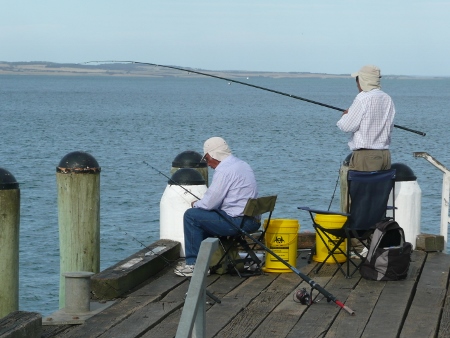
Fishing From Cowes Jetty
Before you start, a recreational fishing licence is essential. These are available online or get one at fishing supply stores and other stores.
For fishing licence information go to vfa.vic.gov.auClick the map below to download this map of land based fishing spots. (Map courtesy of Jim's Bait and Tackle, San Remo)
Another essential is to check the Bureau of Meteorology weather report for the Westernport area.
Go to http://www.bom.gov.au/vic/forecasts/westernport.shtmlFamiliarize yourself with catch restrictions as all species have legal sizes and bag limits.
Popular Phillip Island fishing spots are in the channel between Cowes and the mainland, as well as Westernport Bay.
For tide and fishing times go to www.tideschart.comSee the report below for the best fishing spots and fishing tips for Westernport Bay.
Diving for abalone is restricted.
Fisheries Victoria publishes the nominated days for the recreational harvesting of abalone - contact them for dates.
In Westernport Bay the abalone bag limit is 5 (no more than two green lip).
Remember that taking abalone from the intertidal zone (waters less than 2 metres deep) is prohibited.
Help stop the spread of abalone disease by observing the following practices:
- Wash vessels, wet suits, dive equipment and hands with soapy water
- Remove all marine organic matter from vessels and equipment
- Dispose of abalone shell, gut and meat with household waste
Observe boating safety -
|
Fishing from rocks is a dangerous practice. There have been several drownings off rocks during Phillip Island fishing trips.
Please observe the following safety tips:
- Check weather conditions before leaving
- Tell someone of your plans
- Don't fish by yourself
- Wear a life jacket
- Wear non-slip shoes and head protection
- Beware rogue waves, always watch the sea
On Phillip Island there a several places that are on the high-risk fishing list. These fishing spots comprise Kitty Miller Bay, Pyramid Rock, Sunderland Bay and Cowies Rock Platform.
Anglers in these sites must wear a life jacket.
WHERE AND HOW TO FISH IN SOUTH EASTERN WESTERNPORT BAY
By Craig Edmonds from Jim’s Bait and Tackle, San Remo
I get a lot of visitors to the shop from all parts of the state and country many of whom have been told all these stories that boating in Westernport Bay is dangerous because all you do is get stuck on the mud. Like anywhere you go boating it can be dangerous and Westernport Bay is no different but with a small amount of common sense it can be as safe if not safer than any other boating waterway. The best way to stay out of trouble is to ask someone who knows the area and generally the local tackle shop is the best place to start and while they might not be able to guarantee you will catch a fish if you follow the instructions you are given chances are you will avoid getting into trouble. The most important rule in the bay is to follow the channel markers and to know what a danger marker looks like. If unsure, slow down.
There are a few things you need to be aware of to have an enjoyable day fishing in Westernport Bay as it can be quite different to Port Phillip Bay. In Westernport we have current and lots of them, the biggest difference you will find when fishing is you actually need to use sinkers and I don’t mean split shot but large pieces of lead. You will also need to change the size of sinker as the tide changes and you will need to use different size sinkers in different parts of the bay. As a general rule, when you are whiting fishing you are generally in the shallow areas of the bay often as shallow as 1m and you generally use sinkers from 1/2oz to 3oz when you are chasing snapper or gummies you will need 4oz to 8oz in the shallower spots and 8oz to 16oz in the deeper channels with all of the above dependent on the time of the tide.
The biggest advantage we have in Westernport is we have an island in the middle and although it can still get quite rough it is generally a short chop which can be navigated safely. It also means there is generally somewhere you can go to fish. The trick is to know what stage the tide is at and the wind direction as this will determine the safest place to be. Pick a spot in the bay where the tide and wind are going in the same direction as this will be the smoothest area to be but be wary of tide changes as this can make a huge difference in a very short time.
Where to fish? I have listed some of the more popular spots in the bay which should give you a starting point for your days fishing and a general rule in the bay for most fish is about 1 1/2 hours before and after the low or high tide is the best.
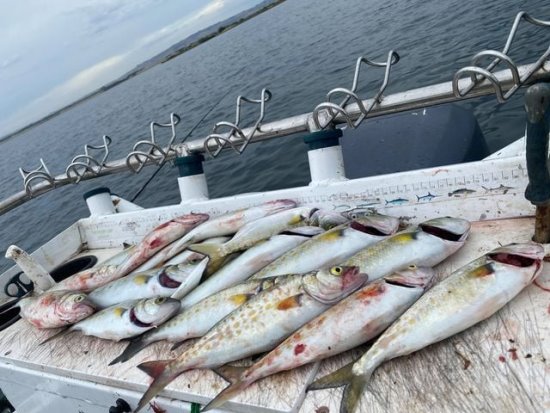
(Photo courtesy of Jim's Bait and Tackle, San Remo)
Dickies Bay - located on the eastern side of the bridge behind the police station where there are plenty of weed and sand patches in about 1m to 2m of water. This is probably one of the most productive areas for whiting and garfish in the bay but if you are fishing in this area don’t forget the squid jig as plenty are caught during the season as well. Size 6 long shank hook or a size 1/0 circle on either a running sinker or paternoster rig with pippie and or squid bait for the whiting with a small amount of burley and enough lead to hold bottom, Whiting snatchers are very productive as well. Size 12 long shank hook with silverfish or dough under a float for the garfish with a bread dough for burley. Move about 1km further ENE and you will come to Maggie Shoal and the Anderson peg again a very popular spot for whiting and the same rig and baits apply but you won’t find as many garfish as the water is slightly deeper. With a slightly different bottom you have a very good chance of finding a few flathead in this area as well as the odd grass whiting. Move another 3 or 4km north and you will come to Reef Island, another spot for whiting. The whiting in this area are generally smaller than Dickies Bay but there can be plenty of them but be careful of the island itself as the rocks can be just under the surface at high tide. As you head to Reef Island there are several spots along the way that can be very productive especially over Christmas when the pinkie snapper move in as well as being a good area for calamari and flathead. From Reef Island head SSW back towards the bridge to the main channel where there are plenty of opportunities to fish. The top end of the channel can produce some very good whiting along the edge, but more weight will be needed as the current is quite strong there. The channel can also be very good for pinkie snapper and flathead, but you will come across a bit more rubbish in the form of stingrays and Port Jackson sharks. The channel is also a very good place to troll a lure or two for salmon and pike but remember it is a main channel and will get very busy with boating traffic at times.
From the top of the main channel at San Remo you can head towards French Island. North will take you to places like Corinella and Elizabeth Island, North west will take you to Ram Island and Tortoise Head all very good for bigger snapper and gummies, but you will be fishing in deeper water and this is where the 8oz to 12oz sinkers will come in useful. There are far too many fishing spots to mention in this report but generally you are fishing in either a deep hole or on the edge of the channel and it pays to spend a bit of time with your sounder to ensure you are fishing on a ledge or the bank on the channel. As well as your sinkers changing size you will need to change hook size and style with circles or octopus style hooks from 4/0 to 8/0 needed again depending on the bait and rig used. Running sinker or paternoster rig is the angler’s preference as we get enough reports to suggest one works as good as the other and as a rule the bigger hooks are used on a running sinker rig. Baits vary again to the angler’s preference, but squid and pilchard would account for about 80% of our reports. From Elizabeth Island head SSW towards Rhyll and about ½ way you will come across the Corals about 6m deep, an area well known for snapper and gummies. In summer generally the fish are a bit smaller in size than the deeper areas but certainly a lot easier to fish as you can drop down to a 4oz or 6oz sinker. This area is also a very good area to take the kids as there is usually something to catch, even if it is undersize flathead, and keeps them occupied for ages. You will get pestered by small flathead, but I have seen plenty of good size flathead return from this area this season. For the snapper and gummies hooks, baits and rigs are the same as the deeper water with just a change of sinker. One advantage though in this area is to be able to read your sounder as you can easily pick up schools of fish and with a bit of burley you can have a successful days outing.
If you want to stay a bit closer to the Newhaven boat ramp or the wind is coming from the NW and you want somewhere calmer, head towards Cleeland Bight, west of the bridge. Stay to the correct side of the channel markers in the Bight as on your port side on the way down is a big sand bar. There are several places to fish in the bight and the edge of the sand bar can be very productive for flathead on the right day, just anchor on the side of the channel and fish back to the sand bar. The whiting can be very good further west towards the two green channel markers fishing in about 3 to 4m of water but fish on the Woolamai beach side. You can also pick up some reasonable size pinkies and gummies on the edge of the channel. Another good spot for whiting is further towards the entrance where you will see a big sand hill and fishing only a few 100m from the beach is where you need to be in about 2.5 to 3m of water. Like the rest of the bay shallower water smaller sinkers deeper water bigger sinkers and the rigs and baits remain the same. The bight is also a very good place for calamari and you will need to be in about 2.5m of water from the sand hill to the public mooring buoys. Anglers use either a baited jig under a float or an artificial jig and both methods work. Like all lure fishing the colour of the jig will depend on the day but as a general rule natural-coloured jigs work best with the better swimming more expensive ones much better. You need to take some caution in this area as it can get very busy with kayaks, jet skis and water skiers all trying to use the same area of water. Also be careful if you are anchoring along the channel as it is the main channel for the commercial boats which can put up a large wake as they go past.
The last place to mention is offshore and it is a place you should only head if you are confident in your ability as things can change very quickly. There is some good fishing to be had offshore, but I would suggest you drop in and see us at the shop for all the information you will need as it is very different to in the bay.
The above report is reprinted with the kind permission of Craig Edmonds of Jim's Bait and Tackle, San Remo, and Phillip Island Vibe magazine.
For Westernport Bay fishing maps go to www.jimsbaitandtackle.com.au
There are three boat ramps on Phillip Island, and fishing boats can be launched free of any charges.
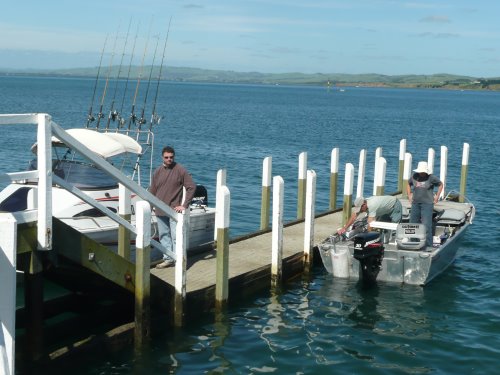

Newhaven has a two-lane ramp, parking for car/trailers, and also car-only spaces.
A fish cleaning table is available and is a great place to watch pelicans feeding. Try to spot the huge stingray circling for a feed as well!
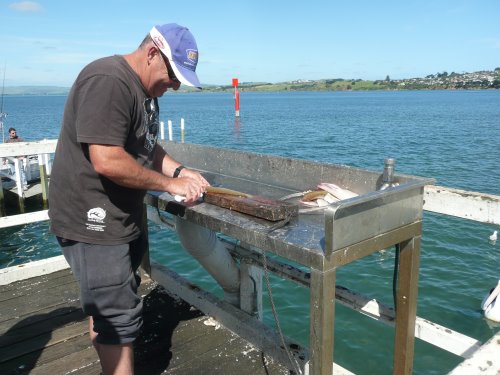
Cleaning The Catch After a Phillip Island Fishing Trip

Cleaning The Catch After a Phillip Island Fishing Trip
Anderson Street boat ramp and jetty in Cowes has parking for about cars/trailers plus separate spaces for cars.
A
kiosk is on site selling fishing licences, tackle, and bait as well as
food, drinks, and ice creams. Toilet facilities are available.
Rhyll boat facility has parking for cars and trailers and a three-lane ramp, plus cleaning table.
Return to Top
Return to Phillip Island Beaches from Phillip Island Fishing
Return to Home Page
Keep in touch - sign up for my free newsletter!
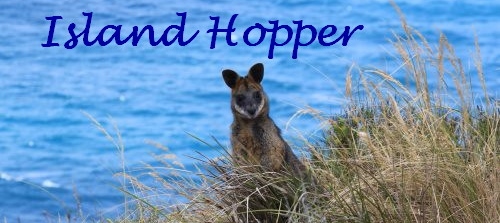
Copyright 2011-2025 phillip-island-balcony.com
All Rights Reserved
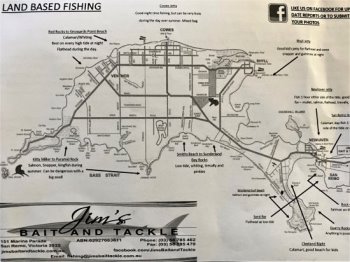
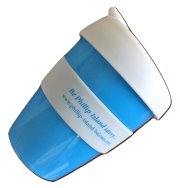
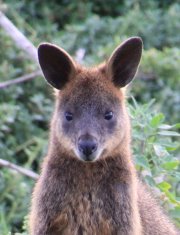
New! Comments
Have your say about what you just read! Leave me a comment in the box below.